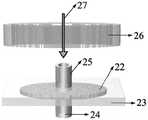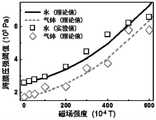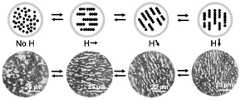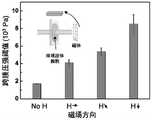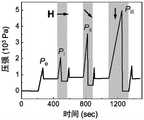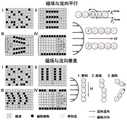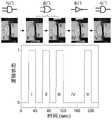CN112570050B - Fluid transportation control system and method - Google Patents
Fluid transportation control system and methodDownload PDFInfo
- Publication number
- CN112570050B CN112570050BCN201910927575.0ACN201910927575ACN112570050BCN 112570050 BCN112570050 BCN 112570050BCN 201910927575 ACN201910927575 ACN 201910927575ACN 112570050 BCN112570050 BCN 112570050B
- Authority
- CN
- China
- Prior art keywords
- fluid
- magnetic field
- control system
- colloidal
- colloidal suspension
- Prior art date
- Legal status (The legal status is an assumption and is not a legal conclusion. Google has not performed a legal analysis and makes no representation as to the accuracy of the status listed.)
- Active
Links
- 239000012530fluidSubstances0.000titleclaimsabstractdescription120
- 238000000034methodMethods0.000titleabstractdescription15
- 239000002245particleSubstances0.000claimsabstractdescription64
- 239000000725suspensionSubstances0.000claimsabstractdescription59
- 239000012528membraneSubstances0.000claimsabstractdescription57
- 230000005684electric fieldEffects0.000claimsabstractdescription3
- 239000011148porous materialSubstances0.000claimsdescription26
- RYGMFSIKBFXOCR-UHFFFAOYSA-NCopperChemical compound[Cu]RYGMFSIKBFXOCR-UHFFFAOYSA-N0.000claimsdescription14
- 229910052802copperInorganic materials0.000claimsdescription14
- 239000010949copperSubstances0.000claimsdescription14
- 239000006260foamSubstances0.000claimsdescription14
- 239000007788liquidSubstances0.000claimsdescription14
- 239000000463materialSubstances0.000claimsdescription10
- 229920002261Corn starchPolymers0.000claimsdescription2
- XAGFODPZIPBFFR-UHFFFAOYSA-NaluminiumChemical compound[Al]XAGFODPZIPBFFR-UHFFFAOYSA-N0.000claimsdescription2
- 229910052782aluminiumInorganic materials0.000claimsdescription2
- 239000008120corn starchSubstances0.000claimsdescription2
- 229910001220stainless steelInorganic materials0.000claimsdescription2
- 239000010935stainless steelSubstances0.000claimsdescription2
- 229940099112cornstarchDrugs0.000claims1
- 230000003287optical effectEffects0.000claims1
- 239000002131composite materialSubstances0.000abstractdescription28
- 230000002776aggregationEffects0.000abstractdescription7
- 238000004220aggregationMethods0.000abstractdescription7
- 230000001105regulatory effectEffects0.000abstractdescription7
- 230000004044responseEffects0.000abstractdescription2
- 239000000243solutionSubstances0.000description21
- 239000000084colloidal systemSubstances0.000description15
- 238000012360testing methodMethods0.000description15
- 230000009471actionEffects0.000description11
- 230000008859changeEffects0.000description10
- 239000003814drugSubstances0.000description9
- 229940079593drugDrugs0.000description9
- 238000010586diagramMethods0.000description7
- XLYOFNOQVPJJNP-UHFFFAOYSA-NwaterChemical compoundOXLYOFNOQVPJJNP-UHFFFAOYSA-N0.000description6
- NIXOWILDQLNWCW-UHFFFAOYSA-Nacrylic acid groupChemical groupC(C=C)(=O)ONIXOWILDQLNWCW-UHFFFAOYSA-N0.000description5
- 238000000520microinjectionMethods0.000description5
- PYWVYCXTNDRMGF-UHFFFAOYSA-Nrhodamine BChemical compound[Cl-].C=12C=CC(=[N+](CC)CC)C=C2OC2=CC(N(CC)CC)=CC=C2C=1C1=CC=CC=C1C(O)=OPYWVYCXTNDRMGF-UHFFFAOYSA-N0.000description5
- 229940043267rhodamine bDrugs0.000description5
- 238000010008shearingMethods0.000description5
- 230000015572biosynthetic processEffects0.000description4
- 230000001276controlling effectEffects0.000description4
- 239000008367deionised waterSubstances0.000description4
- 229910021641deionized waterInorganic materials0.000description4
- 230000008569processEffects0.000description4
- HEMHJVSKTPXQMS-UHFFFAOYSA-MSodium hydroxideChemical compound[OH-].[Na+]HEMHJVSKTPXQMS-UHFFFAOYSA-M0.000description3
- 230000007423decreaseEffects0.000description3
- 239000004205dimethyl polysiloxaneSubstances0.000description3
- 235000013870dimethyl polysiloxaneNutrition0.000description3
- 230000033001locomotionEffects0.000description3
- 239000006249magnetic particleSubstances0.000description3
- CXQXSVUQTKDNFP-UHFFFAOYSA-NoctamethyltrisiloxaneChemical compoundC[Si](C)(C)O[Si](C)(C)O[Si](C)(C)CCXQXSVUQTKDNFP-UHFFFAOYSA-N0.000description3
- 238000004987plasma desorption mass spectroscopyMethods0.000description3
- 229920000435poly(dimethylsiloxane)Polymers0.000description3
- 230000004043responsivenessEffects0.000description3
- 238000007789sealingMethods0.000description3
- 230000003373anti-fouling effectEffects0.000description2
- 230000033228biological regulationEffects0.000description2
- 230000003247decreasing effectEffects0.000description2
- 238000013461designMethods0.000description2
- 239000011521glassSubstances0.000description2
- 230000002209hydrophobic effectEffects0.000description2
- 230000003993interactionEffects0.000description2
- 238000011160researchMethods0.000description2
- 238000001338self-assemblyMethods0.000description2
- 239000007787solidSubstances0.000description2
- RBTBFTRPCNLSDE-UHFFFAOYSA-N3,7-bis(dimethylamino)phenothiazin-5-iumChemical compoundC1=CC(N(C)C)=CC2=[S+]C3=CC(N(C)C)=CC=C3N=C21RBTBFTRPCNLSDE-UHFFFAOYSA-N0.000description1
- 230000009286beneficial effectEffects0.000description1
- 230000000739chaotic effectEffects0.000description1
- 150000001875compoundsChemical class0.000description1
- 239000013078crystalSubstances0.000description1
- 230000007547defectEffects0.000description1
- 238000009792diffusion processMethods0.000description1
- 230000007246mechanismEffects0.000description1
- 229960000907methylthioninium chlorideDrugs0.000description1
- 238000012986modificationMethods0.000description1
- 230000004048modificationEffects0.000description1
- 238000012544monitoring processMethods0.000description1
- 229920000642polymerPolymers0.000description1
- 238000002360preparation methodMethods0.000description1
- 229920006268silicone filmPolymers0.000description1
- 238000004088simulationMethods0.000description1
- 238000004381surface treatmentMethods0.000description1
- 230000007704transitionEffects0.000description1
Images
Classifications
- B—PERFORMING OPERATIONS; TRANSPORTING
- B01—PHYSICAL OR CHEMICAL PROCESSES OR APPARATUS IN GENERAL
- B01L—CHEMICAL OR PHYSICAL LABORATORY APPARATUS FOR GENERAL USE
- B01L3/00—Containers or dishes for laboratory use, e.g. laboratory glassware; Droppers
- B01L3/50—Containers for the purpose of retaining a material to be analysed, e.g. test tubes
- B01L3/502—Containers for the purpose of retaining a material to be analysed, e.g. test tubes with fluid transport, e.g. in multi-compartment structures
- B01L3/5027—Containers for the purpose of retaining a material to be analysed, e.g. test tubes with fluid transport, e.g. in multi-compartment structures by integrated microfluidic structures, i.e. dimensions of channels and chambers are such that surface tension forces are important, e.g. lab-on-a-chip
- B01L3/50273—Containers for the purpose of retaining a material to be analysed, e.g. test tubes with fluid transport, e.g. in multi-compartment structures by integrated microfluidic structures, i.e. dimensions of channels and chambers are such that surface tension forces are important, e.g. lab-on-a-chip characterised by the means or forces applied to move the fluids
- B—PERFORMING OPERATIONS; TRANSPORTING
- B01—PHYSICAL OR CHEMICAL PROCESSES OR APPARATUS IN GENERAL
- B01L—CHEMICAL OR PHYSICAL LABORATORY APPARATUS FOR GENERAL USE
- B01L3/00—Containers or dishes for laboratory use, e.g. laboratory glassware; Droppers
- B01L3/50—Containers for the purpose of retaining a material to be analysed, e.g. test tubes
- B01L3/502—Containers for the purpose of retaining a material to be analysed, e.g. test tubes with fluid transport, e.g. in multi-compartment structures
- B01L3/5027—Containers for the purpose of retaining a material to be analysed, e.g. test tubes with fluid transport, e.g. in multi-compartment structures by integrated microfluidic structures, i.e. dimensions of channels and chambers are such that surface tension forces are important, e.g. lab-on-a-chip
- B01L3/502746—Containers for the purpose of retaining a material to be analysed, e.g. test tubes with fluid transport, e.g. in multi-compartment structures by integrated microfluidic structures, i.e. dimensions of channels and chambers are such that surface tension forces are important, e.g. lab-on-a-chip characterised by the means for controlling flow resistance, e.g. flow controllers, baffles
- B—PERFORMING OPERATIONS; TRANSPORTING
- B01—PHYSICAL OR CHEMICAL PROCESSES OR APPARATUS IN GENERAL
- B01L—CHEMICAL OR PHYSICAL LABORATORY APPARATUS FOR GENERAL USE
- B01L3/00—Containers or dishes for laboratory use, e.g. laboratory glassware; Droppers
- B01L3/50—Containers for the purpose of retaining a material to be analysed, e.g. test tubes
- B01L3/502—Containers for the purpose of retaining a material to be analysed, e.g. test tubes with fluid transport, e.g. in multi-compartment structures
- B01L3/5027—Containers for the purpose of retaining a material to be analysed, e.g. test tubes with fluid transport, e.g. in multi-compartment structures by integrated microfluidic structures, i.e. dimensions of channels and chambers are such that surface tension forces are important, e.g. lab-on-a-chip
- B01L3/502761—Containers for the purpose of retaining a material to be analysed, e.g. test tubes with fluid transport, e.g. in multi-compartment structures by integrated microfluidic structures, i.e. dimensions of channels and chambers are such that surface tension forces are important, e.g. lab-on-a-chip specially adapted for handling suspended solids or molecules independently from the bulk fluid flow, e.g. for trapping or sorting beads, for physically stretching molecules
- G—PHYSICS
- G01—MEASURING; TESTING
- G01N—INVESTIGATING OR ANALYSING MATERIALS BY DETERMINING THEIR CHEMICAL OR PHYSICAL PROPERTIES
- G01N15/00—Investigating characteristics of particles; Investigating permeability, pore-volume or surface-area of porous materials
- G01N15/10—Investigating individual particles
- G01N15/14—Optical investigation techniques, e.g. flow cytometry
- G01N15/1404—Handling flow, e.g. hydrodynamic focusing
- B—PERFORMING OPERATIONS; TRANSPORTING
- B01—PHYSICAL OR CHEMICAL PROCESSES OR APPARATUS IN GENERAL
- B01L—CHEMICAL OR PHYSICAL LABORATORY APPARATUS FOR GENERAL USE
- B01L2200/00—Solutions for specific problems relating to chemical or physical laboratory apparatus
- B01L2200/06—Fluid handling related problems
- B01L2200/0636—Focussing flows, e.g. to laminate flows
- B—PERFORMING OPERATIONS; TRANSPORTING
- B01—PHYSICAL OR CHEMICAL PROCESSES OR APPARATUS IN GENERAL
- B01L—CHEMICAL OR PHYSICAL LABORATORY APPARATUS FOR GENERAL USE
- B01L2200/00—Solutions for specific problems relating to chemical or physical laboratory apparatus
- B01L2200/06—Fluid handling related problems
- B01L2200/0694—Creating chemical gradients in a fluid
- G—PHYSICS
- G01—MEASURING; TESTING
- G01N—INVESTIGATING OR ANALYSING MATERIALS BY DETERMINING THEIR CHEMICAL OR PHYSICAL PROPERTIES
- G01N15/00—Investigating characteristics of particles; Investigating permeability, pore-volume or surface-area of porous materials
- G01N15/10—Investigating individual particles
- G01N15/14—Optical investigation techniques, e.g. flow cytometry
- G01N15/1404—Handling flow, e.g. hydrodynamic focusing
- G01N15/1409—Handling samples, e.g. injecting samples
- G—PHYSICS
- G01—MEASURING; TESTING
- G01N—INVESTIGATING OR ANALYSING MATERIALS BY DETERMINING THEIR CHEMICAL OR PHYSICAL PROPERTIES
- G01N15/00—Investigating characteristics of particles; Investigating permeability, pore-volume or surface-area of porous materials
- G01N15/10—Investigating individual particles
- G01N15/14—Optical investigation techniques, e.g. flow cytometry
- G01N15/1434—Optical arrangements
- G01N2015/144—Imaging characterised by its optical setup
- G—PHYSICS
- G01—MEASURING; TESTING
- G01N—INVESTIGATING OR ANALYSING MATERIALS BY DETERMINING THEIR CHEMICAL OR PHYSICAL PROPERTIES
- G01N15/00—Investigating characteristics of particles; Investigating permeability, pore-volume or surface-area of porous materials
- G01N15/10—Investigating individual particles
- G01N15/14—Optical investigation techniques, e.g. flow cytometry
- G01N2015/1477—Multiparameters
Landscapes
- Chemical & Material Sciences (AREA)
- Health & Medical Sciences (AREA)
- Dispersion Chemistry (AREA)
- Analytical Chemistry (AREA)
- General Health & Medical Sciences (AREA)
- Hematology (AREA)
- Clinical Laboratory Science (AREA)
- Chemical Kinetics & Catalysis (AREA)
- Physics & Mathematics (AREA)
- Life Sciences & Earth Sciences (AREA)
- Biochemistry (AREA)
- General Physics & Mathematics (AREA)
- Immunology (AREA)
- Pathology (AREA)
- Fluid Mechanics (AREA)
- Colloid Chemistry (AREA)
Abstract
Description
Translated fromChinese技术领域technical field
本发明属微流控技术领域,具体涉及一种流体输运控制系统及方法。The invention belongs to the technical field of microfluidics, and in particular relates to a fluid transport control system and method.
背景技术Background technique
胶体悬浮液是指一种胶体颗粒弥散分布在另一种载液中形成的悬浮液体系。由于胶体颗粒的结构和聚集状态直接影响材料的自组装,晶体的缺陷,材料的相变,生物体分子级的组装,胶体颗粒的聚集行为一直是胶体界面与科学、材料学以及工程领域的研究热点。其中包括胶体颗粒自组装形成超结构,自驱动颗粒,群体输运行为,颗粒机器人,微流体控制,生物体中颗粒物的移动,以及颗粒物的扩散机理研究等。这些研究基本上都是基于颗粒自身运动行为和聚集状态的研究,尚未涉及颗粒物聚集行为尤其是颗粒物的混乱度对流体输运行为的控制。Colloidal suspension refers to a suspension system in which one colloidal particle is dispersed and distributed in another carrier liquid. Since the structure and aggregation state of colloidal particles directly affect the self-assembly of materials, the defects of crystals, the phase transition of materials, the assembly of biological molecules, the aggregation behavior of colloidal particles has always been the research field of colloidal interface and science, materials science and engineering. hot spot. These include self-assembly of colloidal particles to form superstructures, self-propelled particles, swarm transport behavior, particle robotics, microfluidic control, movement of particles in organisms, and research on the diffusion mechanism of particles. These studies are basically based on the particle's own motion behavior and aggregation state, and have not yet dealt with the particle aggregation behavior, especially the control of the particle's disorder on the fluid transport behavior.
发明内容SUMMARY OF THE INVENTION
本发明的主要目的,在于提供流体输运控制系统及方法。The main object of the present invention is to provide a fluid transport control system and method.
为解决上述技术问题,本发明的技术方案如下:For solving the above-mentioned technical problems, the technical scheme of the present invention is as follows:
一种流体输运控制系统,包括:A fluid transport control system comprising:
用于容纳液体的多孔膜,所述的多孔膜设有至少一待输运流体入口以及一待输运流体出口;A porous membrane for accommodating liquid, the porous membrane is provided with at least one fluid inlet to be transported and one fluid outlet to be transported;
载液,含有响应性胶体颗粒的胶体悬浮液;carrier fluid, a colloidal suspension containing responsive colloidal particles;
外场,所述的外场能够作用于载液中的响应性胶体颗粒。The external field can act on the responsive colloidal particles in the carrier liquid.
步骤(1)中所述的胶体悬浮液包括但不限于磁流变液、电流变液、玉米淀粉溶液等。The colloidal suspension described in step (1) includes but is not limited to magnetorheological fluid, electrorheological fluid, corn starch solution and the like.
步骤(1)中所述的胶体悬浮液浓度质量分数为10~80wt.%。The concentration mass fraction of the colloidal suspension described in step (1) is 10-80 wt.%.
步骤(1)中所述的胶体颗粒粒径为2~5μm。The particle size of the colloidal particles described in step (1) is 2-5 μm.
步骤(2)中所述的多孔膜材料包括但不限于泡沫铜、泡沫不锈钢、泡沫铝、以及聚合物多孔材料。The porous membrane materials described in step (2) include but are not limited to foamed copper, foamed stainless steel, foamed aluminum, and polymer porous materials.
步骤(2)中所述的多孔膜孔径为10~50μm。The pore size of the porous membrane described in step (2) is 10-50 μm.
步骤(3)中所述的胶体悬浮液在多孔膜中的饱和度为70~150%。The saturation of the colloidal suspension in the porous membrane in step (3) is 70-150%.
步骤(5)中微量注射泵的流速为100-1500μL/min。In step (5), the flow rate of the micro-injection pump is 100-1500 μL/min.
步骤(6)中的外场包括但不限于磁场、电场、声场或光场。The external field in step (6) includes but is not limited to a magnetic field, an electric field, a sound field or a light field.
步骤(6)中的外场大小为50-600Gauss的磁场。The magnitude of the external field in step (6) is a magnetic field of 50-600 Gauss.
步骤(6)中的外场方向为平行于输运方向,垂直于输运方向,或与输运方向呈一定的角度,例如1-89度。The direction of the external field in step (6) is parallel to the transport direction, perpendicular to the transport direction, or at a certain angle, such as 1-89 degrees, with the transport direction.
步骤(6)中的外场为一定频率的交流磁场或旋转磁场。The external field in step (6) is an alternating magnetic field or a rotating magnetic field with a certain frequency.
本发明还提供流体输运控制方法,包括如下步骤:The present invention also provides a fluid transport control method, comprising the steps of:
1)组装前述的流体输送控制系统;1) Assemble the aforementioned fluid delivery control system;
2)在待输运流体进入流体输送控制系统之前或是进入之后,调整外场的作用力大小以及方向,改变胶体悬浮液中的响应性胶体颗粒的排列方式,从而控制待输运流体的输送状态。2) Before or after the fluid to be transported enters the fluid transport control system, adjust the magnitude and direction of the force of the external field, and change the arrangement of the responsive colloidal particles in the colloidal suspension, thereby controlling the transport state of the fluid to be transported .
本发明通过毛细力将胶体悬浮液限域在多孔膜骨架中,制备了一种具有固/液/固多相界面的复合膜体系。其中的胶体悬浮液具有外场响应性。利用外场精确控制胶体颗粒在限域空间的混乱度,即熵,来调控流体通过限域胶体体系的能力。在外场作用下,胶体颗粒沿着外场排列成有序的链状结构,增加了胶体悬浮液自身的粘度,该悬浮液的屈服应力增加,从而另外一种流体通过该液体复合膜时所需的压强阈值增加,通过动态调控外场的大小和方向均可以有效调节流体过膜的输运能力。该流体输运控制系统具有非接触调控,实时的刺激响应性,和优异的抗污染性能,并可进一步设计形成逻辑微流控系统,达到智能可控的逻辑输出。The invention confines the colloidal suspension in the porous membrane framework by capillary force, and prepares a composite membrane system with a solid/liquid/solid multiphase interface. The colloidal suspension in it has external field responsiveness. An external field is used to precisely control the degree of disorder of colloidal particles in the confined space, that is, entropy, to control the ability of fluids to pass through a confined colloidal system. Under the action of the external field, the colloidal particles are arranged into an ordered chain structure along the external field, which increases the viscosity of the colloidal suspension itself, and the yield stress of the suspension increases, so that another fluid passes through the liquid composite membrane. When the pressure threshold increases, the fluid transport capacity across the membrane can be effectively regulated by dynamically adjusting the magnitude and direction of the external field. The fluid transport control system has non-contact regulation, real-time stimulus responsiveness, and excellent anti-pollution performance, and can be further designed to form a logic microfluidic system to achieve intelligent and controllable logic output.
本发明的有益效果:Beneficial effects of the present invention:
1.在待输运流体进入流体输送控制系统之前或是进入之后,通过控制所施加的外场的强度来控制限域胶体颗粒的混乱度及胶体悬浮液的流变行为,可以调控另外一种流体过膜的输运行为。1. Before or after the fluid to be transported enters the fluid transport control system, by controlling the intensity of the applied external field to control the disorder of the confined colloidal particles and the rheological behavior of the colloidal suspension, another fluid can be regulated. Transport behavior through the membrane.
2.在一定外场强度下,在待输运流体进入流体输送控制系统之前或是进入之后,仅仅通过调节施加的外场方向,可以调控流体过膜的输运行为。2. Under a certain external field strength, before or after the fluid to be transported enters the fluid transport control system, the transport behavior of the fluid across the membrane can be regulated only by adjusting the direction of the applied external field.
3.通过设计组合多个限域胶体体系,可以得到多种流体输运状态的逻辑微流控系统。3. By designing and combining multiple confined colloid systems, a logical microfluidic system with multiple fluid transport states can be obtained.
4.在输运流体的过程中,含胶体悬浮液的复合膜体系具有非接触控制、实时响应性、优异的循环稳定性和优异的抗污染性能。4. In the process of transporting fluids, the composite membrane system containing colloidal suspension has non-contact control, real-time responsiveness, excellent cycle stability and excellent anti-pollution performance.
附图说明Description of drawings
图1为本发明基于限域胶体颗粒混乱度调控的流体输运控制系统的示意图。1为限域孔道空间,2为响应性胶体颗粒,3为胶体颗粒的载液,4为质量分数较低的限域胶体体系,5为优化的质量分数下的限域胶体体系,6为胶体颗粒完全紧密填充孔道空间的限域胶体体系,4~6状态说明通过控制优化的限域尺寸和优化的质量分数可以有效调控限域胶体颗粒的熵。7为6状态下施加外场时的状态(质量分数达到完全填充孔道空间时,外场对胶体颗粒的可调性很小),8~13分别为在优化的胶体颗粒质量分数下,外场对限域胶体的熵良好的可控性,14为胶体悬浮液,15为待输运流体,16~21分别为对应与8~13状态下,流体的输运能力示意图,其中8为水平方向的磁场下,限域胶体颗粒的状态,16为8状态下输运流体的输运行为,此时胶体颗粒的熵为Si,输运流体通过限域胶体体系的跨膜压强阈值为Pi。9为水平状态下增加磁场强度限域胶体颗粒的状态,对应17为9状态下输运流体的输运行为,此时胶体颗粒的熵为Si’,输运流体通过限域胶体体系的跨膜压强阈值为Pi’。10为磁场方向与水平方向呈倾斜一定角度(如45°)限域胶体颗粒的状态,18为对应10状态下输运流体的输运行为,此时胶体颗粒的熵为Sii,输运流体通过限域胶体体系的跨膜压强阈值为Pii。11为磁场方向与水平方向呈90°角限域胶体颗粒的状态,19为对应11状态下输运流体的输运行为,此时胶体颗粒的熵为Siii,输运流体通过限域胶体体系的跨膜压强阈值为Piii。12为磁场方向与水平方向呈另一种倾斜角度下(如135°)限域胶体颗粒的状态,20为对应12状态下输运流体的输运行为,此时胶体颗粒的熵为Siv,输运流体通过限域胶体体系的跨膜压强阈值为Piv。13为无磁场时限域胶体颗粒的状态,21为对应13状态下输运流体的输运行为,此时胶体颗粒的熵为So,输运流体通过限域胶体体系的跨膜压强阈值为Po。FIG. 1 is a schematic diagram of the fluid transport control system based on the regulation of the disorder of confined colloidal particles according to the present invention. 1 is the confined pore space, 2 is the responsive colloidal particles, 3 is the carrier liquid of the colloidal particles, 4 is the confined colloidal system with a lower mass fraction, 5 is the confined colloidal system at the optimized mass fraction, and 6 is the colloid The confinement colloid system in which the particles completely and tightly fill the pore space,
图2为本发明在外场下的跨膜压强阈值测试示意图。22为多孔膜材料,23为亚克力板密封腔体,24为待输运流体进口,25为待输运流体出口,26为磁铁,27为所施加的磁场方向。FIG. 2 is a schematic diagram of a transmembrane pressure threshold test under an external field of the present invention. 22 is the porous membrane material, 23 is the acrylic plate sealing cavity, 24 is the inlet of the fluid to be transported, 25 is the outlet of the fluid to be transported, 26 is the magnet, and 27 is the direction of the applied magnetic field.
图3为在有无磁场作用下限域胶体颗粒的形貌、格子法模拟的颗粒分布和不同大小的外场作用下的熵的改变。Figure 3 shows the morphology of the confined colloidal particles with or without the action of a magnetic field, the particle distribution simulated by the lattice method, and the change of entropy under the action of external fields of different sizes.
图4为本发明在有无磁场作用下限域胶体颗粒控制流体输运的示意图和气体的跨膜压强阈值改变。FIG. 4 is a schematic diagram of the control of fluid transport by confined colloidal particles and the change of the gas transmembrane pressure threshold under the presence or absence of a magnetic field according to the present invention.
图5为本发明在不同磁场强度下的Mason数以及胶体悬浮液的粘度。Figure 5 shows the Mason number and the viscosity of the colloidal suspension of the present invention under different magnetic field strengths.
图6为本发明胶体颗粒熵的改变量与气体跨膜压强阈值的相关性。Fig. 6 is the correlation between the change amount of the entropy of the colloidal particles of the present invention and the gas transmembrane pressure threshold.
图7为本发明在不同磁场强度下气体和液体的跨膜压强阈值及其理论曲线。Fig. 7 is the transmembrane pressure threshold and theoretical curve of gas and liquid under different magnetic field strengths of the present invention.
图8为本发明气体的跨膜压强阈值随着磁场状态的动态改变而改变,即动态改变磁场强度与动态降低磁场强度,气体的跨膜压强阈值随之变化。8 shows that the transmembrane pressure threshold of the gas in the present invention changes with the dynamic change of the magnetic field state, that is, dynamically changing the magnetic field intensity and dynamically decreasing the magnetic field intensity, and the transmembrane pressure threshold of the gas changes accordingly.
图9为本发明不同磁场方向下胶体颗粒的分布的示意图和显微镜图。9 is a schematic diagram and a microscope view of the distribution of colloidal particles in different magnetic field directions of the present invention.
图10为本发明不同磁场方向下气体通过胶体悬浮液复合膜体系的跨膜压强阈值。FIG. 10 shows the transmembrane pressure thresholds of gas passing through the colloidal suspension composite membrane system under different magnetic field directions of the present invention.
图11为本发明输运气体时的压强随着磁场方向动态改变而变化。Fig. 11 shows the pressure change of the present invention when the gas is transported as the direction of the magnetic field changes dynamically.
图12为本发明磁场与输运流体流向平行和垂直的格子法模拟示意图,以及输运流体剪切胶体颗粒的相互作用示意图。12 is a schematic diagram of the lattice method simulation of the magnetic field and the flow direction of the transport fluid parallel and perpendicular to the present invention, and a schematic diagram of the interaction of the transport fluid shearing colloidal particles.
图13为本发明在胶体颗粒随机分布、有序成链、以及输运流体形成通路这三个过程的熵的改变。Fig. 13 shows the change of entropy in the three processes of random distribution of colloidal particles, ordered chain formation, and formation of channels by transport fluid.
图14为本发明通过磁场控制胶体悬浮液复合膜体系的药物释放能力。Figure 14 shows the drug release capability of the colloidal suspension composite membrane system controlled by a magnetic field according to the present invention.
图15为本发明组合两个胶体悬浮液复合膜体系,并通过磁场控制逻辑微流控。Fig. 15 shows the combination of two colloidal suspension composite membrane systems according to the present invention, and the logic microfluidics is controlled by a magnetic field.
图16为本发明通过改变磁场方向控制目标溶液输运能力。FIG. 16 shows the control of the transport capacity of the target solution by changing the direction of the magnetic field in the present invention.
图17为本发明与裸膜体系对比,胶体悬浮液复合膜体系具有优异的抗污染性能。Figure 17 shows the comparison between the present invention and the bare membrane system, the colloidal suspension composite membrane system has excellent anti-fouling performance.
具体实施方式Detailed ways
以下通过具体实施方式结合附图对本发明的技术方案进行进一步的说明和描述。对本领域的技术人员在不背离本发明的精神和保护范围情况下做出的其它的变化和修改,仍包括在本发明保护范围之内。The technical solutions of the present invention will be further illustrated and described below through specific embodiments in conjunction with the accompanying drawings. Other changes and modifications made by those skilled in the art without departing from the spirit and protection scope of the present invention are still included in the protection scope of the present invention.
本发明的系统制备方法如下:The system preparation method of the present invention is as follows:
(1)配制一定质量浓度具有外场响应的胶体悬浮液,表征其在不同剪切速率下的粘度和剪切力。(1) Prepare a certain mass concentration of colloidal suspension with external field response, and characterize its viscosity and shear force at different shear rates.
(2)设计并制备一定孔径大小的多孔膜材料,表征其孔径大小、孔径分布以及孔隙率。选择的多孔膜材料为疏水材料或通过表面处理使得多孔膜表面疏水。(2) Design and prepare a porous membrane material with a certain pore size, and characterize its pore size, pore size distribution and porosity. The selected porous membrane material is a hydrophobic material or the surface of the porous membrane is made hydrophobic by surface treatment.
(3)取适量步骤(1)所制备的胶体悬浮液,与步骤(2)制备的多孔膜复合,胶体悬浮液浸润并进入多孔膜的孔道,填充所有多孔膜孔隙,呈现过饱和填充状态。(3) Take an appropriate amount of the colloidal suspension prepared in step (1) and compound it with the porous membrane prepared in step (2).
(4)设计流体输运装置,上下两片亚克力板分别有流体进口与出口,含进口的亚克力板留有放置液体复合膜材料的槽位,将复合好的胶体悬浮液复合膜体系放置含槽位透明亚克力板中,通过硅胶膜将上下两片亚克力板密封好。通过固定螺母和螺栓将其完全密封。(4) Design a fluid transport device. The upper and lower acrylic sheets have fluid inlets and outlets respectively. The acrylic sheet with the inlet has a slot for placing the liquid composite membrane material, and the composite colloidal suspension composite membrane system is placed in a slot containing In the transparent acrylic sheet, seal the upper and lower acrylic sheets with a silicone film. It is completely sealed by securing nuts and bolts.
(5)将步骤(4)的密封装置连接在跨膜压强测试装置中,设置一定的流速,通过微量注射泵推动气体或液体,通过压强传感器测试气体和液体通过该胶体悬浮液复合体系的跨膜压强阈值,并通过数据采集系统记录实时的压强-时间曲线。(5) Connect the sealing device of step (4) in the transmembrane pressure test device, set a certain flow rate, push the gas or liquid through the micro-injection pump, and test the transmembrane flow of the gas and the liquid through the colloidal suspension composite system through the pressure sensor Membrane pressure threshold, and record real-time pressure-time curve through data acquisition system.
(6)将步骤(4)的密封装置连接在跨膜压强测试装置中,施加一定大小的外场,并通过微量注射泵推动气体或液体,测试气体和液体通过该胶体悬浮液复合膜体系的跨膜压强阈值。(6) Connect the sealing device of step (4) in the transmembrane pressure test device, apply a certain size of external field, and push the gas or liquid through a micro-injection pump, and test the gas and liquid through the colloidal suspension composite membrane system. Membrane pressure threshold.
实施例1:Example 1:
将100μm孔径的PDMS多孔膜放置在玻璃片上,将10μL质量分数为75wt.%的胶体悬浮液(磁流变液,即微米级的胶体悬浮液)注入PDMS多孔膜的小孔中,用光学显微镜观察无磁场下和磁场作用下胶体颗粒的聚集行为,如图3所示,无磁场作用下颗粒物无序排列,在磁场作用下颗粒物沿磁场方向有序排列,通过理论模型格子法模拟限域小孔中的颗粒物的熵值变化,有磁场作用下,限域孔道内颗粒物的熵值减小,并且随着外场强度的增加,熵值的该变量增加。说明可以通过外场调控限域空间胶体颗粒的混乱度。A PDMS porous membrane with a pore size of 100 μm was placed on a glass slide, and 10 μL of a colloidal suspension with a mass fraction of 75 wt. Observe the aggregation behavior of colloidal particles in the absence of a magnetic field and under the action of a magnetic field. As shown in Figure 3, the particles are arranged in disorder without the action of a magnetic field, and the particles are arranged in an orderly manner along the direction of the magnetic field under the action of a magnetic field. The entropy value of the particles in the pores changes. Under the action of the magnetic field, the entropy value of the particles in the confined pores decreases, and with the increase of the external field strength, the variable of the entropy value increases. It shows that the disorder of colloidal particles in confined space can be controlled by an external field.
实施例2:Example 2:
将质量分数为75wt.%的胶体悬浮液(磁流变液)注入于20μm孔径的泡沫铜中,将其密封在如图2的装置中,通过微量注射泵输运30mL空气,设置流速为1000μL/min,测试气体通过胶体悬浮液复合膜体系的跨膜压强阈值。施加平行于输运方向的磁场,磁场大小为300Gauss,并测试磁场下气体的跨膜压强阈值。如图4所示,在无磁场和磁场下,气体的跨膜压强阈值具有显著的改变,并且周期性地改变磁场状态,可以有效调节气体的跨膜压强阈值,实现了流体输运行为的有效控制。在外场作用下,磁性颗粒沿着外场呈现柱链状排列,磁性颗粒受到磁性力FM与粘性力FV的共同作用,Mason数为粘性力FV与磁性力FM的比值,当外场强度增加时,胶体颗粒受到的磁性力增加,胶体悬浮液的粘度增加(图5),此时输运流体通过限域胶体体系的剪切胶体悬浮液的屈服应力增加,从而输运流体的跨膜压强阈值增加,其阈值与胶体颗粒熵的改变量如图6所示。The colloidal suspension (magnetorheological fluid) with a mass fraction of 75 wt.% was injected into copper foam with a pore size of 20 μm, and it was sealed in the device as shown in Figure 2, and 30 mL of air was transported through a micro syringe pump, and the flow rate was set to 1000 μL /min, the transmembrane pressure threshold of the test gas passing through the colloidal suspension composite membrane system. Apply a magnetic field parallel to the transport direction with a magnitude of 300 Gauss, and test the transmembrane pressure threshold of the gas under the magnetic field. As shown in Figure 4, in the absence of a magnetic field and a magnetic field, the transmembrane pressure threshold of the gas has a significant change, and the state of the magnetic field is periodically changed, which can effectively adjust the transmembrane pressure threshold of the gas and realize the effective fluid transport behavior. control. Under the action of the external field, the magnetic particles are arranged in a columnar chain along the external field. The magnetic particles are subjected to the combined action of the magnetic force FM and the viscous force FV. The Mason number is the ratio of the viscous force FV to the magnetic force FM. When the external field strength When increasing, the magnetic force on the colloidal particles increases, and the viscosity of the colloidal suspension increases (Fig. 5). At this time, the yield stress of the shearing colloidal suspension of the transport fluid through the confined colloidal system increases, so that the transmembrane of the transport fluid is increased. As the pressure threshold increases, the threshold and colloidal particle entropy change are shown in Figure 6.
实施例3:Example 3:
将质量分数为75wt.%的胶体悬浮液(磁流变液)注入于20μm孔径的泡沫铜中,将其密封在如图2的装置中,通过微量注射泵输运30mL空气或去离子水,设置流速为1000μL/min,测试气体和去离子水通过胶体悬浮液复合膜体系的跨膜压强阈值。施加平行于输运方向的磁场,逐步增加从0到600Gauss的磁场强度,在每一个磁场强度下测试气体或水的跨膜压强阈值,如图7所示,可以发现,随着磁场强度的增大,气体和水的跨膜压强阈值升高,通过微调磁场强度可以精确地调节流体的输运行为。A colloidal suspension (magnetorheological fluid) with a mass fraction of 75 wt.% was injected into copper foam with a pore size of 20 μm, which was sealed in the device as shown in Figure 2, and 30 mL of air or deionized water was transported through a micro-syringe pump. Set the flow rate to 1000 μL/min, and test the transmembrane pressure threshold of gas and deionized water passing through the colloidal suspension composite membrane system. Apply a magnetic field parallel to the transport direction, gradually increase the magnetic field strength from 0 to 600 Gauss, and test the transmembrane pressure threshold of gas or water at each magnetic field strength, as shown in Figure 7, it can be found that with the increase of the magnetic field strength. The transmembrane pressure thresholds of gas and water are raised, and the fluid transport behavior can be precisely regulated by fine-tuning the magnetic field strength.
实施例4:Example 4:
将质量分数为75wt.%的胶体悬浮液(磁流变液)注入于20μm孔径的泡沫铜中,将其密封在如图2的装置中,通过微量注射泵输运30mL空气,设置流速为1000μL/min,测试气体通过胶体悬浮液复合膜体系的跨膜压强阈值。如图8所示,在通气体的时候,动态施加平行于输运方向的磁场,动态增加磁场强度和动态减小磁场强度,实时检测压强与时间的相关性,每改变一个磁场之间均撤去磁场,让胶体颗粒回复混乱状态,结果表明,随着磁场强度的动态增大,气体的跨膜压强阈值升高,随着磁场强度的动态减小,气体的跨膜压强阈值减小,中间随时撤去磁场,压强又恢复到无外场的初始值,通过动态调控磁场强度可以动态调节流体的输运行为。The colloidal suspension (magnetorheological fluid) with a mass fraction of 75 wt.% was injected into copper foam with a pore size of 20 μm, and it was sealed in the device as shown in Figure 2, and 30 mL of air was transported through a micro syringe pump, and the flow rate was set to 1000 μL /min, the transmembrane pressure threshold of the test gas passing through the colloidal suspension composite membrane system. As shown in Figure 8, when the gas is vented, a magnetic field parallel to the transport direction is dynamically applied, the magnetic field strength is dynamically increased and the magnetic field strength is dynamically decreased, the correlation between pressure and time is detected in real time, and the magnetic field is removed every time the magnetic field is changed. The magnetic field makes the colloidal particles return to the chaotic state. The results show that with the dynamic increase of the magnetic field strength, the gas transmembrane pressure threshold increases, and with the dynamic decrease of the magnetic field strength, the gas transmembrane pressure threshold decreases. When the magnetic field is removed, the pressure returns to the initial value without the external field, and the fluid transport behavior can be dynamically adjusted by dynamically adjusting the magnetic field strength.
实施例5:Example 5:
将100μm孔径的PDMS多孔膜放置在玻璃片上,将10μL质量分数为75wt.%的胶体悬浮液(磁流变液)注入PDMS多孔膜的小孔中,用光学显微镜观察无磁场下和不同磁场方向作用下胶体颗粒的聚集行为,如图9所示。将质量分数为75wt.%的胶体悬浮液(磁流变液)注入于20μm孔径的泡沫铜中,将其密封在如图2的装置中,通过微量注射泵输运30mL空气,设置流速为1000μL/min,分别施加平行于流体输运方向,与输运方向呈45°角,垂直于输运方向的磁场,测试每一种状态下气体通过胶体悬浮液复合膜体系的跨膜压强阈值,可以发现,在这三种磁场方向下,垂直于输运方向下的气体压强阈值最高,而平行于流体方向的气体压强阈值最小,有磁场作用的气体压强阈值均比无磁场下的阈值高,如图10所示。这一实施例说明,在不改变磁场强度的条件下,仅仅改变磁场方向就能调控流体的输运行为。A PDMS porous membrane with a pore size of 100 μm was placed on a glass slide, and 10 μL of a colloidal suspension (magnetorheological fluid) with a mass fraction of 75 wt.% was injected into the pores of the PDMS porous membrane. The aggregation behavior of colloidal particles under the action is shown in Figure 9. The colloidal suspension (magnetorheological fluid) with a mass fraction of 75 wt.% was injected into copper foam with a pore size of 20 μm, and it was sealed in the device as shown in Figure 2, and 30 mL of air was transported through a micro syringe pump, and the flow rate was set to 1000 μL /min, respectively apply a magnetic field parallel to the fluid transport direction, at an angle of 45° to the transport direction, and perpendicular to the transport direction to test the transmembrane pressure threshold of the gas passing through the colloidal suspension composite membrane system in each state. It is found that under the three magnetic field directions, the gas pressure threshold perpendicular to the transport direction is the highest, while the gas pressure threshold parallel to the fluid direction is the smallest. shown in Figure 10. This embodiment shows that, without changing the strength of the magnetic field, only changing the direction of the magnetic field can control the transport behavior of the fluid.
实施例6:Example 6:
将质量分数为75wt.%的胶体悬浮液(磁流变液)注入于20μm孔径的泡沫铜中,将其密封在如图2的装置中,通过微量注射泵输运30mL空气,设置流速为1000μL/min,在无磁场作用下,测试气体的跨膜压强阈值,在通气体的同时分别动态施加平行于流体输运方向,与输运方向呈45°角,垂直于输运方向的磁场,实时监测气体通过胶体悬浮液复合膜体系的压强(图11),可以发现,在气体流通的状态下,动态施加不同方向的磁场,均可以动态调控流体的输运行为。The colloidal suspension (magnetorheological fluid) with a mass fraction of 75 wt.% was injected into copper foam with a pore size of 20 μm, and it was sealed in the device as shown in Figure 2, and 30 mL of air was transported through a micro syringe pump, and the flow rate was set to 1000 μL /min, in the absence of a magnetic field, test the transmembrane pressure threshold of the gas, and dynamically apply a magnetic field parallel to the fluid transport direction, at an angle of 45° to the transport direction, and perpendicular to the transport direction, real-time By monitoring the pressure of the gas passing through the colloidal suspension composite membrane system (Figure 11), it can be found that under the state of gas circulation, the dynamic application of magnetic fields in different directions can dynamically control the fluid transport behavior.
实施例7:Example 7:
通过格子法计算了磁场方向与输运流体方向平行和与输运流体方向垂直两种极端情况下的胶体颗粒的熵,如图12和图13所示,这两种情况下,输运流体与胶体悬浮液的相互作用分为四个阶段,I为随机分布,II为有序化,III为剪切过程,IV为形成通路。对于磁场方向与流向平行时,输运流体在剪切胶体悬浮液时需要克服的是磁性链之间的作用力,链的移动所需的转动惯量较小;而磁场方向与流向垂直时,输运流体在剪切胶体悬浮液时需要克服的是磁性颗粒之间的作用力,需要经历流体与磁性链的剪切、链的脱离以及链的旋转三个过程,此时链的移动所需的转动惯量较大,因此磁场方向与输运流体方向垂直时流体的跨膜压强阈值较大。通过格子法计算得到磁场方向平行和垂直于输运方向两种情况下,胶体颗粒在随机分布、有序化和形成通路时的熵值,如图13。可以发现在有序化时,磁场方向垂直与流向的情况下颗粒的熵值比磁场方向平行于流向下的熵值要小,此时需要更多的能量才能让输运流体通过胶体悬浮液,即输运流体的跨膜压强阈值较高,输运流体的输运能力减弱。The entropy of colloidal particles in two extreme cases where the direction of the magnetic field is parallel to the direction of the transport fluid and perpendicular to the direction of the transport fluid is calculated by the lattice method, as shown in Figure 12 and Figure 13. In these two cases, the transport fluid and The interaction of colloidal suspensions is divided into four stages, I is random distribution, II is ordered, III is shear process, and IV is channel formation. When the magnetic field direction is parallel to the flow direction, the transport fluid needs to overcome the force between the magnetic chains when shearing the colloidal suspension, and the moment of inertia required for the movement of the chains is small; while when the magnetic field direction is perpendicular to the flow direction, the transport fluid needs to overcome the force between the magnetic chains. What the transport fluid needs to overcome when shearing the colloidal suspension is the force between the magnetic particles, and it needs to go through three processes: the shearing of the fluid and the magnetic chain, the detachment of the chain, and the rotation of the chain. The moment of inertia is larger, so the transmembrane pressure threshold of the fluid is larger when the direction of the magnetic field is perpendicular to the direction of the transport fluid. The entropy values of colloidal particles in random distribution, ordering and formation of channels under the condition that the magnetic field direction is parallel and perpendicular to the transport direction are obtained by the lattice method, as shown in Figure 13. It can be found that during ordering, the entropy value of the particles is smaller when the magnetic field direction is perpendicular to the flow direction than the entropy value of the magnetic field direction parallel to the flow direction. At this time, more energy is required to allow the transport fluid to pass through the colloidal suspension. That is, the transmembrane pressure threshold of the transport fluid is higher, and the transport capacity of the transport fluid is weakened.
实施例8:Example 8:
将质量分数为75wt.%的胶体悬浮液(磁流变液)注入于20μm孔径的泡沫铜中,将其密封在如图14的装置中,通过微量注射泵输运30mL的亚甲基蓝药物溶液,通过磁场控制药物溶液的释放状态,同时通过压强传感器测试流体的跨膜压强阈值。通过微量注射泵的恒流模式,设置流速为1000μL/min,测试流体的跨膜压强阈值为1650Pa。如图14,在初始状态下,通过微量注射泵将药物溶液注入装置的入口,用恒压模式驱动药物溶液,设置驱动压为2000Pa,此时药物溶液可以释放。当施加一定大小的磁场,用同样大小的驱动压强输送药物溶液,此时磁场可以阻止药物释放,当撤掉磁场,药物溶液又可以释放出来。The colloidal suspension (magnetorheological fluid) with a mass fraction of 75 wt.% was injected into copper foam with a pore size of 20 μm, and it was sealed in the device as shown in Figure 14, and 30 mL of methylene blue drug solution was transported by a micro syringe pump. The magnetic field controls the release state of the drug solution, while the transmembrane pressure threshold of the fluid is tested by a pressure sensor. Through the constant flow mode of the micro syringe pump, set the flow rate to 1000 μL/min, and the transmembrane pressure threshold of the test fluid is 1650 Pa. As shown in Figure 14, in the initial state, the drug solution is injected into the inlet of the device through a micro-injection pump, and the drug solution is driven in constant pressure mode, and the driving pressure is set to 2000Pa, and the drug solution can be released at this time. When a magnetic field of a certain size is applied and the drug solution is delivered with the same driving pressure, the magnetic field can prevent the release of the drug, and when the magnetic field is removed, the drug solution can be released again.
实施例9:Example 9:
取一定量质量分数为75wt.%的胶体悬浮液(磁流变液),将其注入于20μm孔径的泡沫铜中,制备两个胶体悬浮液复合膜体系(多孔膜孔径相同),将其安装在Y型的微流体管路中,通过磁场控制微流体在两个等效通路中流体的输运能力,可以获得逻辑微流控,如“与门”、“或门”和“非门”。如图15,首先通过恒流模式测试流体通过每一个胶体悬浮液复合膜体系的跨膜压强阈值,设置驱动压强值使其高于流体的跨膜压强阈值,此时驱动压强均高于各个复合膜体系的跨膜压强阈值,两个通路的流体均能过膜,此时形成了逻辑“与门”(状态I)。当在其中一个流体管路上施加磁场时,用同样的驱动压2000Pa驱动目标流体时,无磁场的管路允许流体通过,有磁场的管路流体无法通过,此时形成“或门”(状态II和III)。当两个管路上均施加磁场时,两个管路的流体均无法通过,此时形成“非门”(状态IV)。如果同时撤去两个管路的磁场,那么,两个管路的流体又均能通过,此时再次形成“与门”(状态V)。Take a certain amount of colloidal suspension (magnetorheological fluid) with a mass fraction of 75 wt.%, inject it into copper foam with a pore size of 20 μm, prepare two colloidal suspension composite membrane systems (with the same pore size of the porous membrane), and install them. In the Y-shaped microfluidic pipeline, by controlling the transport ability of the microfluidic fluid in the two equivalent channels by the magnetic field, logic microfluidics such as "AND gate", "OR gate" and "NOT gate" can be obtained. . As shown in Figure 15, first test the transmembrane pressure threshold of the fluid passing through each colloidal suspension composite membrane system in the constant flow mode, and set the driving pressure value to be higher than the transmembrane pressure threshold of the fluid. At this time, the driving pressure is higher than each composite membrane system. The transmembrane pressure threshold of the membrane system, the fluid in both channels can pass through the membrane, and a logical "AND gate" (state I) is formed at this time. When a magnetic field is applied to one of the fluid pipelines and the target fluid is driven with the same driving pressure of 2000Pa, the pipeline without the magnetic field allows the fluid to pass through, but the pipeline with the magnetic field cannot pass through, and an "OR gate" is formed at this time (state II and III). When a magnetic field is applied to both pipelines, the fluids in both pipelines cannot pass through, and a "NOT gate" (state IV) is formed at this time. If the magnetic fields of the two pipelines are removed at the same time, the fluids in the two pipelines can pass through again, and an "AND gate" (state V) is formed again at this time.
实施例10:Example 10:
将质量分数为75wt.%的胶体悬浮液(磁流变液)注入于20μm孔径的泡沫铜中,将其密封在如图16的装置中,通过微量注射泵输运30mL的NaOH溶液,通过调控磁场方向控制目标溶液的输运状态,同时通过压强传感器测试流体的跨膜压强阈值。通过微量注射泵的恒流模式,设置流速为1000μL/min,测试流体的跨膜压强阈值。如图16,在初始状态下,将指示剂放置在装置的出口处。当施加一定大小的平行于输运方向的磁场时,测试流体通过的跨膜压强阈值,此时用高于该阈值的恒定驱动压强驱动目标溶液,目标溶液通过复合膜体系,指示剂变色。当施加垂直于输运方向的磁场时,用相同大小的驱动压强,目标溶液不能通过复合膜体系,此时指示剂不变色。说明在不改变驱动压的情况下,仅仅改变外场的作用方向就可以控制一个微反应的进行。The colloidal suspension (magnetorheological fluid) with a mass fraction of 75 wt.% was injected into copper foam with a pore size of 20 μm, and it was sealed in the device as shown in Figure 16, and 30 mL of NaOH solution was transported through a micro syringe pump. The direction of the magnetic field controls the transport state of the target solution, while the transmembrane pressure threshold of the fluid is tested by the pressure sensor. Through the constant flow mode of the micro-injection pump, set the flow rate to 1000 μL/min, and test the transmembrane pressure threshold of the fluid. As shown in Figure 16, in the initial state, the indicator is placed at the outlet of the device. When a magnetic field of a certain magnitude parallel to the transport direction is applied, the transmembrane pressure threshold of the fluid passing through is tested. At this time, the target solution is driven by a constant driving pressure higher than the threshold value, and the target solution passes through the composite membrane system, and the indicator changes color. When a magnetic field perpendicular to the transport direction is applied, with the same driving pressure, the target solution cannot pass through the composite membrane system, and the indicator does not change color at this time. It shows that the progress of a micro-reaction can be controlled only by changing the action direction of the external field without changing the driving pressure.
实施例11:Example 11:
用显微镜观察20μm孔径的泡沫铜的形貌,将泡沫铜密封在如图2的装置中,用500μL/min输运罗丹明B溶液,溶液通过泡沫铜后,将其取出,用去离子水冲洗若干遍,用N2吹干,并用荧光显微镜观察暗场下的膜形貌。将质量分数为75wt.%的胶体悬浮液(磁流变液)注入于另一片20μm孔径的泡沫铜中,显微镜观察其形貌,将胶体悬浮液复合膜体系密封在如图2的装置中,用500μL/min输运罗丹明B溶液,溶液通过复合膜体系后,将其取出,用去离子水冲洗若干遍,用N2吹干,并用荧光显微镜观察暗场下的膜形貌。可以发现胶体悬浮液复合膜体系输运罗丹明B溶液后没有被污染,而裸膜体系输运罗丹明B溶液后已经被罗丹明B污染,说明胶体悬浮液复合膜体系具有优异的抗污染性能(图17)。Use a microscope to observe the morphology of the copper foam with a pore size of 20 μm, seal the copper foam in the device as shown in Figure 2, and transport the Rhodamine B solution at 500 μL/min. After the solution passes through the copper foam, take it out and rinse it with deionized water. Several times,blow dry with N, and observe the film morphology under dark field with a fluorescence microscope. The colloidal suspension (magnetorheological fluid) with a mass fraction of 75 wt.% was injected into another piece of copper foam with a pore size of 20 μm, and its morphology was observed with a microscope, and the colloidal suspension composite membrane system was sealed in the device shown in Figure 2.The Rhodamine B solution was transported at 500 μL/min, and after the solution passed through the composite membrane system, it was taken out, rinsed with deionized water several times, dried with N, and the membrane morphology under dark field was observed with a fluorescence microscope. It can be found that the colloidal suspension composite membrane system is not polluted after transporting Rhodamine B solution, while the bare membrane system has been polluted by Rhodamine B after transporting Rhodamine B solution, indicating that the colloidal suspension composite membrane system has excellent anti-fouling performance. (Figure 17).
Claims (6)
Priority Applications (1)
| Application Number | Priority Date | Filing Date | Title |
|---|---|---|---|
| CN201910927575.0ACN112570050B (en) | 2019-09-27 | 2019-09-27 | Fluid transportation control system and method |
Applications Claiming Priority (1)
| Application Number | Priority Date | Filing Date | Title |
|---|---|---|---|
| CN201910927575.0ACN112570050B (en) | 2019-09-27 | 2019-09-27 | Fluid transportation control system and method |
Publications (2)
| Publication Number | Publication Date |
|---|---|
| CN112570050A CN112570050A (en) | 2021-03-30 |
| CN112570050Btrue CN112570050B (en) | 2022-07-19 |
Family
ID=75110137
Family Applications (1)
| Application Number | Title | Priority Date | Filing Date |
|---|---|---|---|
| CN201910927575.0AActiveCN112570050B (en) | 2019-09-27 | 2019-09-27 | Fluid transportation control system and method |
Country Status (1)
| Country | Link |
|---|---|
| CN (1) | CN112570050B (en) |
Family Cites Families (15)
| Publication number | Priority date | Publication date | Assignee | Title |
|---|---|---|---|---|
| US5900184A (en)* | 1995-10-18 | 1999-05-04 | Lord Corporation | Method and magnetorheological fluid formulations for increasing the output of a magnetorheological fluid device |
| DE10257004A1 (en)* | 2002-12-06 | 2004-06-17 | Steag Microparts Gmbh | Device for the parallel dosing of liquids |
| US7547380B2 (en)* | 2003-01-13 | 2009-06-16 | North Carolina State University | Droplet transportation devices and methods having a fluid surface |
| CN1521499A (en)* | 2003-02-12 | 2004-08-18 | 财团法人工业技术研究院 | Multidirectional logic type micro-fluid control system and method thereof |
| US8037902B2 (en)* | 2003-05-19 | 2011-10-18 | Protasis Corporation | Fluid logic device |
| CN109055495A (en)* | 2006-11-06 | 2018-12-21 | 美艾利尔技术公司 | Device and method using binding member for analysis |
| CN102016595B (en)* | 2008-03-27 | 2014-08-06 | 哈佛学院院长等 | Three-dimensional microfluidic devices |
| CN101498704A (en)* | 2009-03-05 | 2009-08-05 | 上海交通大学 | Valveless micro-flow control gradient real-time reaction chip and reaction control method |
| US20110140706A1 (en)* | 2009-05-07 | 2011-06-16 | Groves John T | Particle-Based Electrostatic Sensing and Detection |
| AU2013208056B2 (en)* | 2012-01-12 | 2015-05-14 | Viavi Solutions Inc. | Article with curved patterns formed of aligned pigment flakes |
| CN103084227B (en)* | 2012-12-13 | 2016-08-03 | 宁波大学 | Chemical experiment device for magnetic composite particle suspension isolation procedures |
| CN103062479A (en)* | 2012-12-31 | 2013-04-24 | 苏州汶颢芯片科技有限公司 | Magnetic responsive micro valve based on micro-fluidic chip and production method thereof |
| US20140274814A1 (en)* | 2013-03-15 | 2014-09-18 | Lester Ludwig | Removable fluidics structures for microarray, microplates, sensor arrays, and other removable media |
| CN108854854B (en)* | 2017-05-16 | 2021-07-20 | 厦门大学 | A functional fluid gating system |
| CN109762802B (en)* | 2019-01-28 | 2021-08-03 | 北京华龛生物科技有限公司 | A kind of cell carrier particle aggregate and preparation method thereof |
- 2019
- 2019-09-27CNCN201910927575.0Apatent/CN112570050B/enactiveActive
Also Published As
| Publication number | Publication date |
|---|---|
| CN112570050A (en) | 2021-03-30 |
Similar Documents
| Publication | Publication Date | Title |
|---|---|---|
| US20230405591A1 (en) | Multi-channel integrated microfluidic chip and method for high-throughput preparation of monodisperse microgels using the same | |
| CN108854854B (en) | A functional fluid gating system | |
| Bhagat et al. | Inertial microfluidics for continuous particle filtration and extraction | |
| Yuan et al. | Dean-flow-coupled elasto-inertial particle and cell focusing in symmetric serpentine microchannels | |
| Dang et al. | Preparation of tadpole-shaped calcium alginate microparticles with sphericity control | |
| CN106215990B (en) | A kind of micro-fluidic module of prepare with scale drop | |
| CN103846068B (en) | Single dispersing polarity opposite sex Janus microballoon of a kind of particle diameter and morphology controllable and preparation method thereof and microfluidic control device used | |
| CN104173294A (en) | Method for preparing PVA microspheres based on microfluidic drop formation technology | |
| Kim | Droplet-based microfluidics for making uniform-sized cellular spheroids in alginate beads with the regulation of encapsulated cell number | |
| CN112570050B (en) | Fluid transportation control system and method | |
| Kim et al. | A microfluidic manifold with a single pump system to generate highly mono-disperse alginate beads for cell encapsulation | |
| US9939439B2 (en) | Microfluidic system having a magnetic particle bed | |
| CN109957597A (en) | Method for detecting biofilm formation and its application and microfluidic chip | |
| Martín‐Roca et al. | Magnetic Colloidal Currents Guided on Self‐Assembled Colloidal Tracks | |
| Wu et al. | High-throughput microfluidic production of droplets and hydrogel microspheres through monolithically integrated microchannel plates | |
| CN109943486A (en) | Microbial co-cultivation method, microfluidic chip and application | |
| US20220168739A1 (en) | Systems and methods for controlled membrane disruption | |
| CN209451870U (en) | A microfluidic device for dual droplet sorting based on magnetic manipulation | |
| US8828715B2 (en) | Particle adhesion assay for microfluidic bifurcations | |
| CN102816695B (en) | Micro-fluidic chip and method for studying effect of fluid shearing force on cell with the micro-fluidic chip | |
| Li et al. | Janus droplets and droplets with multiple heterogeneous surface strips generated with nanoparticles under applied electric field | |
| Zhang et al. | Manipulations of microfluidic droplets using electrorheological carrier fluid | |
| US20180080003A1 (en) | Intercellular separation method for cultured cells | |
| Li et al. | Magnetic liquid gating valve terminal for patterned droplet generation and transportation of highly viscous bioactive fluids | |
| CN202129066U (en) | Microflow-controlled microballoon preparation device |
Legal Events
| Date | Code | Title | Description |
|---|---|---|---|
| PB01 | Publication | ||
| PB01 | Publication | ||
| SE01 | Entry into force of request for substantive examination | ||
| SE01 | Entry into force of request for substantive examination | ||
| GR01 | Patent grant | ||
| GR01 | Patent grant |

